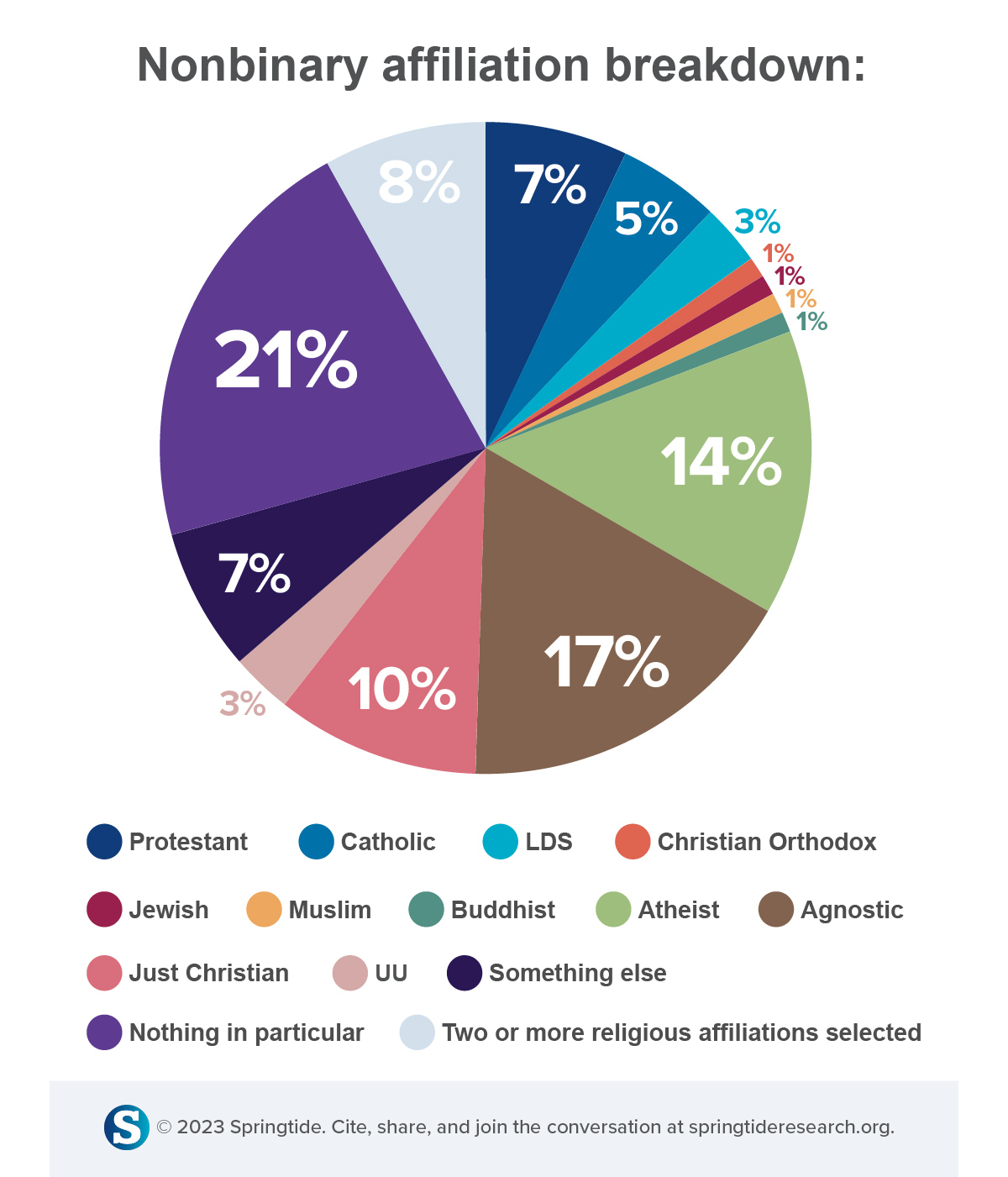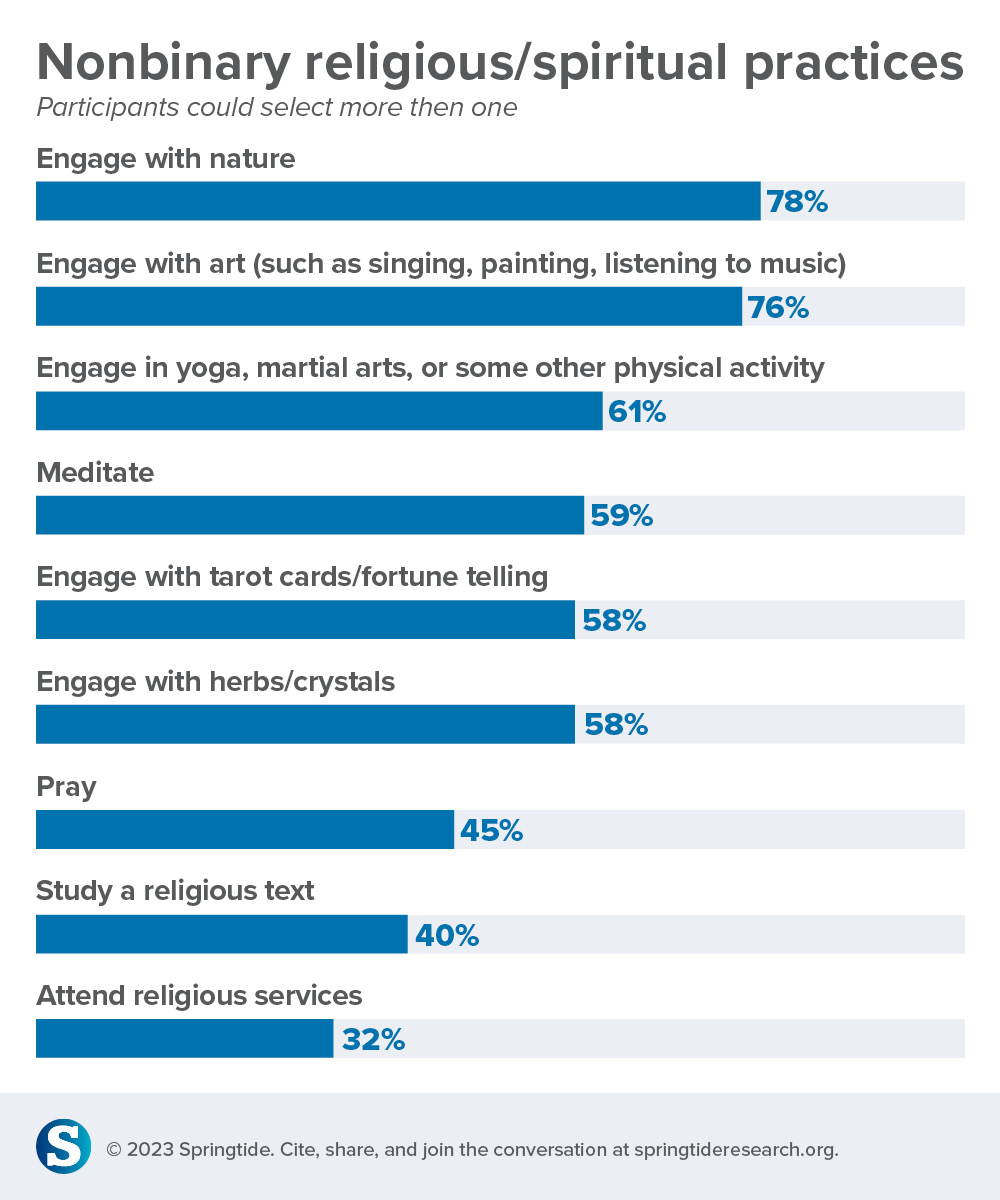11 stats on the religious and spiritual lives of non-binary young people
Of the thousands of young people we surveyed for our research on Gen Z, faith and mental health, one-third said they are not flourishing (another term for succeeding or prospering) in their mental health. Yet, more than half of all nonbinary young people tell us they are not flourishing, compared to about one in four male-identifying young people and one in three female-identifying young people.
But the data show that engaging with religion and spirituality helps, particularly for nonbinary people. Among those nonbinary young people who say they are not spiritual, only 11 percent say they are “flourishing a lot” compared to 25 percent of nonbinary young people who are very spiritual. Only 10 percent of nonbinary young people who say they are not religious say they are “flourishing a lot,” compared to 42 percent of those who are very religious. Yet, only 18 percent of nonbinary young people claim connection to a religious or spiritual community.
Prior social science research shows many nonbinary people are raised in religious and spiritual communities, but these are often the same communities where they first experience marginalization or discrimination. Nonetheless, there’s still many documented ways that religious and spiritual affiliation can positively impact a nonbinary person’s life experience.
These stats reflect details of the religious and spiritual lives of the 503 people who identify as non-binary included in our 2022 data set. While some of these stats may seem like drastic contrasts, they’re reflecting the complex nature of being a young nonbinary person and how that experience shows up differently than their cis counterparts.


-
47 percent of non-binary people consider themselves to be religious, compared to 68 percent of female-identifying and 69 percent of male-identifying participants.
-
77 percent of non-binary people consider themselves to be spiritual, compared to 78 percent of female-identifying and 75 percent of male-identifying participants.
-
When it comes to their belief in a higher power, only 17 percent of non-binary young people say they don’t believe in a higher power, just slightly more than female-identifying (13 percent) and male-identifying (15 percent) participants. Non-binary young people stand out as being more agnostic about the existence of a higher power. 28 percent agree, “I don’t know whether there is a higher power, and I don’t believe there is any way to find out”), than their female-identifying and male-identifying peers (17 percent).
-
18% of non-binary young people say they’re currently connected to a spiritual or religious community, compared to 29% of female-identifying and 33% of male-identifying young people.
-
25 percent of non-binary young people say they feel moderately/highly connected to a higher power, compared to 42 percent of female-identifying and 46 percent of male-identifying participants.
-
65 percent of non-binary young people say they feel moderately/highly connected to the natural environment, compared to 56 percent of female-identifying and 57 percent of male-identifying young people.
-
46 percent of non-binary young people say they are flourishing in their religious/spiritual life, compared to 60 percent of female-identifying and 63 percent of male-identifying young people.
-
51 percent of non-binary young people say they feel judged when they talk about religion/spirituality, compared to 44 percent of female and male-identifying young people.
-
When asked if their parents are supportive of them when it comes to their religious and spiritual practices, 40 percent of non-binary young people disagreed or strongly disagreed, compared to 24 percent of cisgender females and 24percent of cisgender males.
-
60 percent of non-binary people agree, “There are parts of many religions/spiritualities that I agree with,” compared to 64 percent of female-identifying and 60percent of male-identifying participants.
-
47 percent of non-binary people agree, “I feel like I could fit in with many different religions/spiritualities,” compared to 48 percent of female-identifying and 49 percent of male-identifying participants.
Reference: Curley, K. & Leon, R.A. (2019). Religious, secular and spiritual identities: What we know about the transgender and non-binary experience. Journal of Student Affairs, (28), 51-59.






